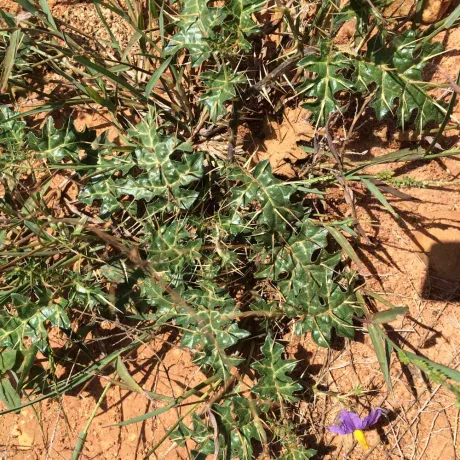Vagbhata specifically indicated Nidigdhika for Kasa. It is extensively used for this purpose in the classical and traditional medicine. Usally two varieties viz., Brihati and Kantakari are described as Brihati dvaya or Kantakari dvaya. Some of the synonyms like Dhavani, Vyaghri and Brihati have been used for both kinds of Kantakari. It is observed that more than one variety or species of both erect and creeping kinds are available for both the plants. But usually one variety each is only accepted in the texts. Kaiyadeva however mentioned two varieties of Kantakari viz., Kantakari (blue flowers) and Sveta Kantakari (white flowers). He had described two Brihati varieties as well viz., Brihati and Sveta Brihati. In Raja Nighantu totally eight varieties of Kantakari are described viz., Sarpatanu, Kasaghni, Lakshmana, Bhantaki, Sveta Brihati, Vrntaki, Brihati and Kantakari. Sveta Kantakari is described as Lakhmana by Bhavamishra. Under Kantakari traya Raja Narahari included Brihati, Agnidamani and Duhsparsa. Bapalalji considered Valli Brihati of Kaiyadeva as Agnidamani. The botanical sources for the above three varieties are : S. indicum; S. trilobatum Linn. & S. surattense Linn.
Botanical Description–
A prickly, diffuse herb. Leaves– ovate or elliptic sinuate or subpinnatifid glabrescent, with straight spines. Flowers– in few flowered lateral cymes, blue-coloured; corolla with shallow lobes, Fruit– globose berries, glabrous, whitish and green-blotched, yellow when ripe. Seeds– many, glaboous. Flowers and fruits from March-July.
Distribution– Common in waste lands and road-sides throughout India.
Major Chemical Constituents–
β-carotene, diosgenin, carpesterol, solasodine, solamargine, α-solamargine, solasonine, solasodino-L-rhamnosyl-B-D-glucoside (solasurine), solanocarpine (solanine-S), tomatidienol etc.
Part Used– Whole plant, root, fruit
Dosage– Decoction 40-80 ml
Research–
(1) Crude plant extract caused hypotension which has been attributed to release of histamine by some constituents (IJMR 1967, 55, 723).
(2) Plant powder is anti-tussive and its beneficial effect in bronchial asthma and non-specific cough has been explained as due to depletion of histamine from lung and its expectorant action as due to inorganic nitrate content (J. Res. Ind. Med. 1971, 6, 200).
(3) The efficacy of Kan¢akŒr¶ on non-specific cough and other respiratory disorders is reported (Chora, 1970 & Krishna, 1971).
(4) Role of Kan¢akŒr¶ in Kasa roga (respiratory disorders) is studied clinically (Singh, 1990).




Reviews
There are no reviews yet.